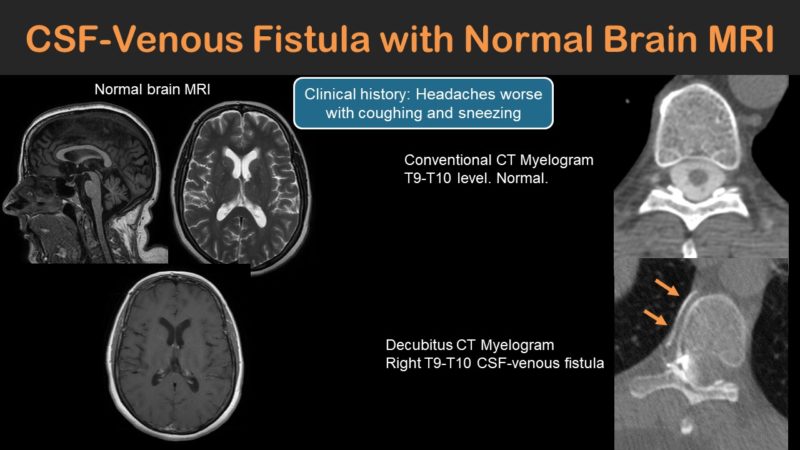For many people experiencing spinal cerebrospinal fluid (CSF) leak, the most prominent symptom is a headache that worsens when upright and improves when lying down. But some patients never experience this kind of orthostatic headache symptom. Kathy Webster was one of them.
Kathy was 55 when she fell ill with a sinus infection. After going to urgent care and taking antibiotics, the infection improved, but she was left with a maddening symptom: an intense head pressure that sharpened into a headache whenever she coughed, sneezed, or bent over. Before this, she’d never experienced a “cough headache,” as she called it, and in fact she had never been prone to migraine or other kinds of head pain. She was a very active person—running, exercising in her home gym—but the strange head pressure and pain put a stop to that.
Like many people with spinal CSF leak searching for answers, Kathy saw many doctors, took many courses of steroids and migraine medications, and had many fruitless imaging scans. Test after test came back “normal,” showing nothing that could be causing Kathy’s symptoms. Frustrated to have no solution after ten months of living with this pain, Kathy searched the internet for “cough headache,” and to her surprise, she found links to information about spinal CSF leak. She emailed her neurologist, excited to share the news. But he wasn’t convinced. He told her it wasn’t possible for her to have a spinal CSF leak because she didn’t have an orthostatic headache.
Fifteen months after her symptoms first began, she was finally able to connect with a specialist who both believed Kathy’s self-diagnosis and understood that more sensitive testing might be needed to prove it. He recommended she have a decubitus, or side-lying, CT myelogram. A CT myelogram is an imaging test performed by a radiologist, who injects contrast material into the space around the spinal cord and nerve roots. Once the contrast is injected, detailed images of the spinal canal can be seen using computed tomography (CT). Often this is done with the patient placed face-down on their stomach, but in the case of a decubitus CT myelogram, the patient is placed on their side. In Kathy’s case, she was placed on her side, on a firm 20-degree angle wedge pillow with her hips tilted upwards. She was injected with contrast in that position, and several scans were performed, one very shortly after she received the contrast injection, and one a few minutes later.
Kathy could tell by the specialist’s face when he walked in the recovery room afterwards that he had good news. And she was right: the first scan he’d taken had showed that Kathy had a CSF-venous fistula. A CSF-venous fistula is an abnormal channel between the spinal subarachnoid space and epidural veins, causing CSF to be circulated into the blood stream instead of contained within the boundaries of the dura mater. Kathy was so excited, she took a picture of the screen as he showed her the image, lit up with contrast. Curiously, the scan that had been taken several minutes later showed nothing. Kathy was lucky. That first, quick scan was able to capture the elusive reason for fifteen months of her strange symptoms.

The next day, Kathy had a fibrin glue injection at the site of her CSF-venous fistula. Afterwards, she felt complete relief. No more cough headache, no more pain when sneezing or bending over. And no rebound high pressure, though she was warned to expect it. Her recovery was quick, and she was able to get back to her active lifestyle within eight weeks.
Kathy has come away from the experience of having a spinal CSF leak for 15 months feeling grateful for the journey. “I’m one of the lucky ones,” she said. “I got the help that I needed.” She wants others to know how important it is to do your own research and keep pushing, and to search for a doctor who is willing to investigate along with you. And she wants medical professionals to know that not everyone who has a spinal CSF leak has an orthostatic headache.
The team at Spinal CSF Leak Foundation extends our appreciation and thanks to the physicians and staff who assisted with this feature story, and to all those working so hard to help patients.
